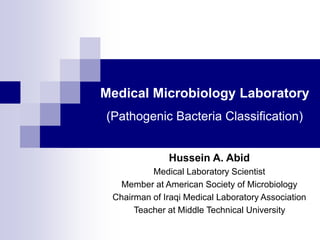
Medical Microbiology Laboratory (pathogenic bacteria classification)
- 1. Medical Microbiology Laboratory (Pathogenic Bacteria Classification) Hussein A. Abid Medical Laboratory Scientist Member at American Society of Microbiology Chairman of Iraqi Medical Laboratory Association Teacher at Middle Technical University
- 2. 2 BACTERIA Bacteria are living organisms that are classified as prokaryotes. They lack membrane-enclosed nuclei and organelles, i.e., mitochondria, Golgi complexes, endoplasmic reticulum. They could be classified according: 1) Morphological properties 2) Anatomical properties 3) Staining reaction 4) Environmental factors 5) Pathogenicity 6) Nutrition 7) Relationship between host and organism
- 3. 3 MORPHOLOGICAL PROPERTIES Morphological properties include (cell shape, size, structure, and arrangements). Bacteria can be classified into six groups according to their morphological properties: 1. True bacteria: divided into two groups cocci and bacilli 2. Actinomycetes 3. Spirochetes 4. Mycoplasmas 5. Rickettsiae 6. Chlamydia
- 4. 4 MORPHOLOGICAL PROPERTIES Actinomycetes: o These are rigid organisms like true bacteria but they resemble fungi in that they exhibit branching and tend to form filaments. o They are termed such because of their resemblance to sun rays when seen in tissue sections. Spirochetes: o These are relatively longer, slender, non- branched microorganisms of spiral shape having several coils. Leptospira interrogans Actinomycetes (Nocardioforms)
- 5. 5 MORPHOLOGICAL PROPERTIES Mycoplasmas: o These bacteria lack in rigid cell wall (cell wall lacking) and are highly pleomorphic and of indefinite shape. o They occur in round or oval bodies and in interlacing filaments. Rickettsiae and chlamydia: o These are very small, obligate parasites, and at one time were considered closely related to the viruses. Now, these are regarded as bacteria.
- 6. 6 ANATOMICAL FEATURES Morphological properties include (capsule, flagella, and spores). According to capsule 1. Capsulated (Streptococcus pneumoniae) 2. Non-capsulated (Viridans streptococci) According to flagella 1. Flagellate (Monotrichous, Lopho-trichous, Amphi-trichous and peritrichous) 2. Afflagellate (e.g. Shigella spp.)
- 7. 7 ANATOMICAL FEATURES According to sporulation 1. Spore forming (e.g. Bacillus spp.) 2. Non-spore forming (Escherichia coli)
- 8. 8 STAINING REACTIONS Gram’s stain reaction: 1. Gram positive (+ve) bacteria: after gram staining procedure, the bacteria appear blue to purple in color. 2. Gram negative (-ve) bacteria: after gram staining procedure, the bacteria appear red to pink in color. Acid-Fast stain reaction: 1. Acid-fast bacteria: after Ziehl-Neelsen staining procedure, the bacteria will appear pink in color. 2. Non-acid-fast bacteria: Ziehl-Neelsen staining procedure, the bacteria will appear blue in color.
- 9. 9 STAINING REACTION (examples) Gram’s stain reaction: 1. Gram positive (+ve) cocci: Staphylococcus aureus 2. Gram negative (-ve) cocci: Neisseria gonorrhoae 3. Gram positive (+ve) bacilli: Clostridium perfringens 4. Gram negative (-ve) bacilli: Pseudomonas aeroginosa Acid-Fast stain reaction: 1. Acid-fast bacteria: Mycobacterium tuberculosis 2. Non-acid-fast bacteria: Staphylococcus aureus
- 10. 10 PATHOGENICITY Pathogenic bacteria: Are able to cause disease (e.g. Salmonella typhi). Non-pathogenic bacteria: Do not cause a disease (e.g. lactobacilli)
- 11. 11 RELATIONSHIP BETWEEN HOST AND ORGANISM Saprophytes: free living microbes on dead animals or decaying things, that can be found in soil and water and play important role in degradation of organic matter. Parasites: that establish themselves and multiply in hosts. Commensals: microbes that live in complete live with harmony, but they can produce disease when host resistance is lowered. (e.g. normal flora organism).
- 12. 12 NUTRITION Autotroph: organism that produces complex organic compounds (such as carbohydrates, fats, and proteins) from simple substances present in its surroundings. Heterotroph: organism that cannot produce its own food, relying instead on the intake of nutrition from other sources of organic carbon, mainly plant or animal matter.
- 13. 13 ENVIRONMENTAL FACTORS 1. Temperature 2. pH 3. Oxygen requirements 4. Living in salt 5. Atmospheric pressure
- 14. 14 TEMPERATURE Psychrophiles (15-20 ºC): Pseudomonas fluorescens Mesophiles (20-40 ºC): Escherichia coli, Staphylococcus aureus Thermophiles (50-60 ºC) Extremely thermophiles (as high as 250 ºC)
- 15. 15 pH Acidophiles Alkaliphiles (e.g.Vibrio spp.) Neutralophiles, pH 6-8, majority of the medically important bacteria grow best at neutral or slightly alkaline media (pH 7.2-7.6).
- 16. 16 OXYGEN REQUIREMENTS Aerobes: grow in ambient temperature, which contains 21% O2 and a small amount of CO2, 0.03% Obligate aerobes: Strictly require O2 for their growth (Pseudomonas aeruginosa) Microaerophilic: grow under reduced O2, 5- 10% and increased CO2, 8-10%; (e.g. Campylobacter jejuni, Helicobacter pylori). Obligate anaerobes: doesn't need O2 for growth, may be inhibited by oxygen.
- 17. 17 OTHER WAYS FOR CLASSIFICATION Motility: motile/non-motile Antibiotic sensitivity: sensitive/resistant Fermentation: fermenter/non-fermenter
- 18. 18 CLASSIFICATION OF PATHOGENIC BACTERIA Gram Positive AnaerobesAerobes BacilliCocciBacilliCocci Clostridium spp.Peptococcus spp.Corynebacterium spp.Staphylococcus spp. Peptostreptococcus spp.Bacillus spp.Streptococcus spp. Listeria spp.Enterococcus spp. Actinimyces spp. Nocardia spp. Lactobacillus spp. Erysipelothrix spp.
- 19. Gram Negative AnaerobesAerobes BacilliCocciBacilliCocci Bacteroides spp.Veillonella spp.EnterobacteriaceaeNeisseria spp. Fusobacterium spp.Pseudomonas spp. Prevotella spp.Brucella spp. Bordetella spp. Francisella spp. Legionella spp. Chlamydia spp. Bartonella spp. Coccobacilli Moraxella spp. Haemophilus spp. 19 CLASSIFICATION OF PATHOGENIC BACTERIA
- 20. 20 CLASSIFICATION OF PATHOGENIC BACTERIA Other bacteria Mycobacterium spp. Mycoplasma spp. Rickettsia spp. Treponema spp. Borrelia spp. Leptospira spp.
- 21. 21 CLASSIFICATION OF PATHOGENIC BACTERIA